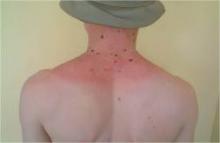In Tanzania, where some of the oldest human fossils have been found, and where Mt. Kilimanjaro rises above the clouds, a group of international dermatologists are hoping to help a very vulnerable population.
The region has one of the highest incidences of albinism in the world.
Although the condition is rare in the western world, it is quite common in sub-Saharan Africa (Dermatol. Clin. 2011;29:79-87). The rate is as high as 1 in 1,400 people, compared with about 1 in 37,000 in the U.S.
Patients with albinism are subject to discrimination, stigma, and even murder.
But, another important concern is the health of patients with albinism whose pink skin is exposed to the African sunshine, and where many occupations are outdoors and in the field.
Many of the locals with albinism die of cancer before age 40; in fact, fewer than 2% make it to their 40th birthday. And almost all of the children with albinism show signs of sun damage before age 10.
Due to lack of funding, many can't afford hats to protect themselves; due to lack of education, many don't know the linkage between sun damage and skin cancer, according to Dr. David McLean, the secretary-general of the International League of Dermatological Societies (ILDS), a nongovernmental organization affiliated with the World Health Organization.
(An audio interview with Dr. McLean is available at the end of this blog.)
Dr. McLean has been visiting the region for the past two decades, helping to establish and grow the Regional Dermatology Training Center (RDTC), an ILDS program, in the town of Moshi in Tanzania.
He is also part of a group who recently spearheaded a project to make hats with a 7.5-cm rim available to the albinism population in Tanzania.
Called "Hats on for Skin Health," a collaboration between the ILDS and Stiefel, the project is a global effort to raise funds for the purchase of hats and other protective items for patients with albinism in Tanzania.
The items will be distributed by the RDTC, which manages a mobile skin care clinic that regularly visits people with albinism living in the region and educates the locals, especially parents, about albinism. The lesson they try to get across, said Dr. McLean, is to let their children play outdoors, but cover them up first.
The group located a hat manufacturer in Moshi, which is currently producing template models for children and adults. Many of the workers, said Dr. McLean, have albinism. "We think that's definitely part of the solution going forward," he said.
The cost of manufacturing a hat in Africa? Less than $2.50, and the hats are expected to last for at least 10 years.
To start the campaign, Stiefel, a subsidiary of GlaxoSmithKline, donated $25,000, and Dr. McLean hopes that dermatologists, other professionals, and even the public, will get involved with the campaign.
"Our people are on the ground there. We know what happens to every donated dollar," said Dr. McLean.
The group expects to have hand out at least 15,000 hats in the next year. Visit www.hatsonforskinhealth.org to learn more.
— Naseem S. Miller (@NaseemSMiller)



